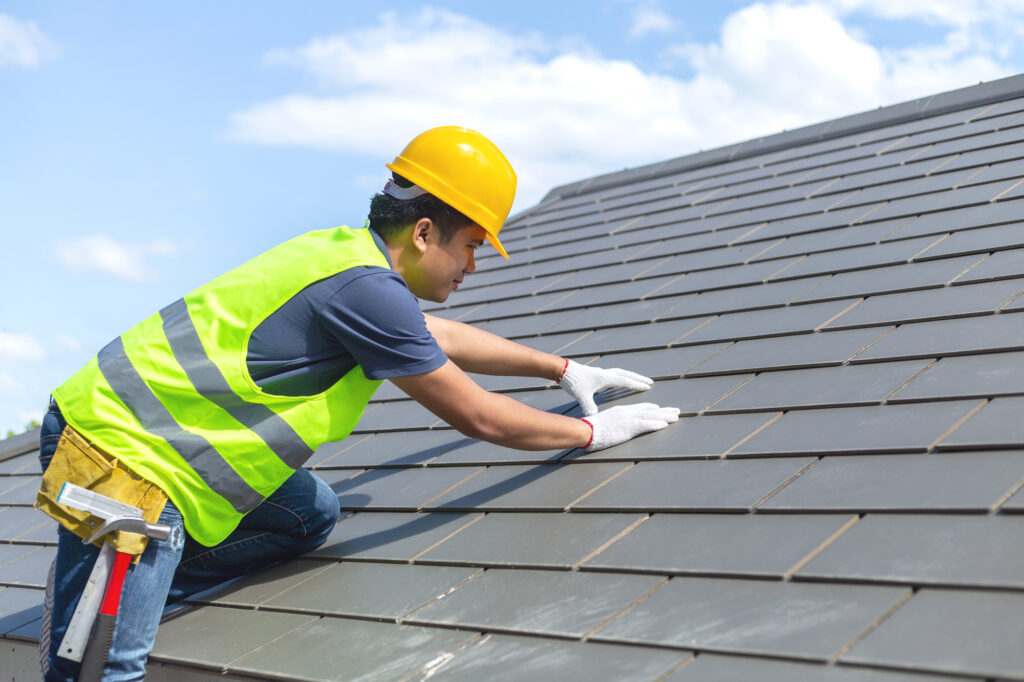Since you clicked on this article, we understand that you want more information about the available options. And you’ve come to the right place, below you’re going to find a guide to commercial roof types.
Choosing the right roof material depending on where you live, can make all the difference. Continue reading this article from end to end before selecting the best roofing material for your home.
Thermoplastic Polyolefin or TPO
This type of roofing material is one of the most popular options for homeowners, and there are many reasons why. TPO is an option that can fit any budget because it’s inexpensive. It also helps to reduce the amount of heat that enters your home because it reflects the sun.
This quality makes it easier to keep your home cooler during the warmer months of the year. And can also help reduce your electric bill because of its ability to reduce heat.
Another great quality of TPO is that it can be installed in various ways, including adhesive to bind it to the roof. One thing you don’t have to worry about with this type of material is the build-up of mold, which can lead to the corrosion and breakdown of your shingles.
Because the way that this type of material is installed, it reduces the likelihood that you’ll experience leaks in your home because the plastic pieces of the material are melted together, closing all of the open seams.
TPO is a laminated material; therefore, you’ll want to ensure that you keep an eye on the weaker points of the material when it’s being installed. This is in case any cracks occur and need to be repaired.
One way to maintain this type of roofing is to ensure that it’s kept clean. A way to do this is to have a pressure washer available to loosen any dirt or debris that’s get trapped on the roof.
Ethylene Propylene Diene Monomer or EPDM
If you don’t want to say the lengthy name of this material, it’s also known as rubber roofing. And one of the reasons much like TPO that many choose to use it is because it’s cheaper in price while still producing high-quality results for people who use it on their roofs.
EPDM can last upwards of 20 years and is lightweight, making it a durable material to use. You’ll also find that it’s excellent at absorbing heat, which again helps your home’s internal temperature remain constant.
However, with anything, there are going to be some things to consider before selecting this one. If you’re not a fan of the color black, then you can choose from one of the other colors that EPDM is offered in.
While it’s great that the material absorbs heat, you may want to choose another color if you’d like the roofing material to reflect the heat instead of absorbing it.
You should understand that purchasing it in another color will increase the overall cost of your purchase. EPDM can be punctured easily, and if it’s punctured, you’ll want to have it repaired speedily to avoid any water leaks.
To maintain EPDM roofing material, you need to clean the roof with a gentle cleaning agent that won’t cause the roof to swell. If the roof swells, the shingles may become loose and will then need to be repaired.
Spray Polyurethane Foam or SPF
This spray material begins as a liquid, and as it’s sprayed turns into a solid. As it continues to dry, it will expand, filling in the gaps and seams of your roof. This spray material is extremely durable and is also energy efficient.
It’s the perfect choice if you’re looking to save money on your electric bill every month. It helps to cut down on energy use because the coating that’s applied over the spray is a reflective coat.
And because it reflects the sun, it reduces energy usage and provides insulation that helps save the heating and air that’s pumped throughout your home. SPF is one of the longest-lasting materials that we’ve listed in this list of commercial roofing materials lasting upwards of 40 years.
There are some steps that you can use to ensure that you maintain the roofing. If you noticed that there are holes or punctures, it’s in your best interest to have them repaired as soon as possible. You should also keep an eye out for any noticeable discoloration taking place on your roof.
Asphalt Rolled
If you’ve got a low sloping roof, then an asphalt rolled roof may be the best option for you and your home. It is easy to install and will fit within the budget that you’ve allotted to have your roofing done.
However, while it is relatively inexpensive, it doesn’t last as long as some of the other options that we’ve placed on our list. But, there are some ways to increase your roof’s life by performing the necessary maintenance and upkeep.
You should routinely clean your roof of any branches or leaves that get caught on it. And you should also regularly give the roof a look over to ensure that there are no areas that need to be repaired to prevent water leaks and damage from occurring.
If you do find an area of the roof that is compromised, contact a professional immediately. One small weak spot could turn into a larger weak spot if not given the appropriate attention.
Acrylic Elastomeric Coating
Acrylic coatings aren’t a roofing material, but instead, its the coating that goes on top of the roofing material that you choose for your home. This coating can withstand even the heaviest of storms without puncturing or being damaged.
The coating adheres to the roofing material and leaves homeowners satisfied with a flawless finish. Still, just like our other roofing types, there are some downfalls to using this acrylic coating. Over time, depending on the weather that your roof is subject to, you may find that the thickness is reduced.
Also, if your roof is flat, you may want to consider another way to coat the roof, or you’ll need to install a system to keep water from pooling on top of the roof’s surface. It can help to reduce the cost of your heating and electric bills.
Polyvinyl Chloride or PVC
This roofing material uses multiple layers of PVC when it’s being installed on your roof. Other materials are added to the PVC to ensure that it’s durable, flexibles and provides stability.
PVC works the best for low sloping and flat roofs and is resistant to several things, including:
- Fire
- Moisture build-up
- Chemicals
- Harsh Winds
All of the things listed above are what you want when it comes to having your roofing installed because it can help give you peace of mind if anything happens to your home. The seams come together to create a barrier that prevents water from being able to seep through.
However, you should keep in mind that this roofing material is on the more expensive end as far as materials go. But, that should be no surprise considering the additives that make it resistant to the elements.
Another cons to look out for is shrinkage; PVC has been known to shrink, and if it does will need to be repaired. When PVC shrinks, it can pull fused seams apart, leaving your home susceptible to water leakage.
PVC is one of the lowest maintenance roofing materials and should be regularly checked by a professional to ensure that there are no repairs that need to be made.
The Best Commercial Roofing Materials Explained
When it comes to the commercial roofing material option that you have for your home’s roof, the options are limitless. One of the best things you can do is speak to a professional and ask them what material they recommend you to use.
Each material has its own pros and cons that should be considered before making your final choices. If you’re looking for a reliable and experienced company to install your roof contact us here at Heins Contracting.
We have the years of experience needed to get the job done the right way. And if that’s not enough, feel free to take a look through the testimonials from clients that have hired us in the past.
From roofing to storm damage, we can fix it all.




